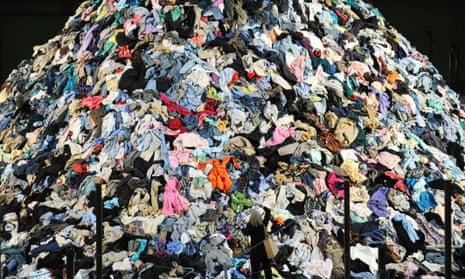MPs are to investigate the environmental impact of throwaway “fast fashion” in the UK amid growing concerns that the multi-billion pound industry is wasting valuable resources and contributing to climate change.
The inquiry, launched on Friday by the House of Commons environmental audit committee, will explore the carbon impact, resource use and water footprint of clothing throughout its lifecycle and supply chain.
Inviting evidence on how the influential sector should remodel itself to be both “thriving and sustainable”, it will look at how improved recycling rates of clothing could slash waste and pollution.
“Fashion shouldn’t cost the Earth” said Mary Creagh MP, chair of the committee. “But the way we design, make and discard clothes has a huge environmental impact. Producing clothes requires climate-changing emissions. Every time we put on a wash, thousands of plastic fibres wash down the drain into the oceans. We don’t know where or how to recycle end-of-life clothing.”
Despite recent troubles on the UK high street, the fashion sector has continued to grow. According to the British Fashion Council, the UK fashion industry contributed £28.1bn to national GDP in 2015, up from £21bn in 2009. But the globalised market for fashion manufacturing has facilitated a “fast fashion” phenomenon; a proliferation of cheap and cheerful clothing, with quick turnover that encourages consumers to keep buying, the committee warns.
The raw materials used to manufacture clothes require land and water, or extraction of fossil fuels, while carbon dioxide is emitted throughout the clothing supply chain and some chemical dyes, finishes and coatings may be toxic. Research has found that plastic microfibres in clothing are released when they are washed, and enter rivers, the ocean and even the food chain.
Last year the fashion designer Stella McCartney condemned her own industry as “incredibly wasteful and harmful to the environment.”
A report from the Ellen MacArthur Foundation put the annual cost to the UK economy of landfilling clothing and household textiles at about £82m. It warned that if the global fashion industry continues on its current growth path, it could use more than a quarter of the world’s annual carbon budget by 2050.
Key to the inquiry is how consumers could be encouraged to buy fewer clothes, reuse clothes and think about how best to dispose of clothes when they are no longer wanted. An estimated 300,000 tonnes of fashion waste goes straight into landfill each year, despite growing efforts to encourage consumers to recycle their worn and unwanted clothing.









